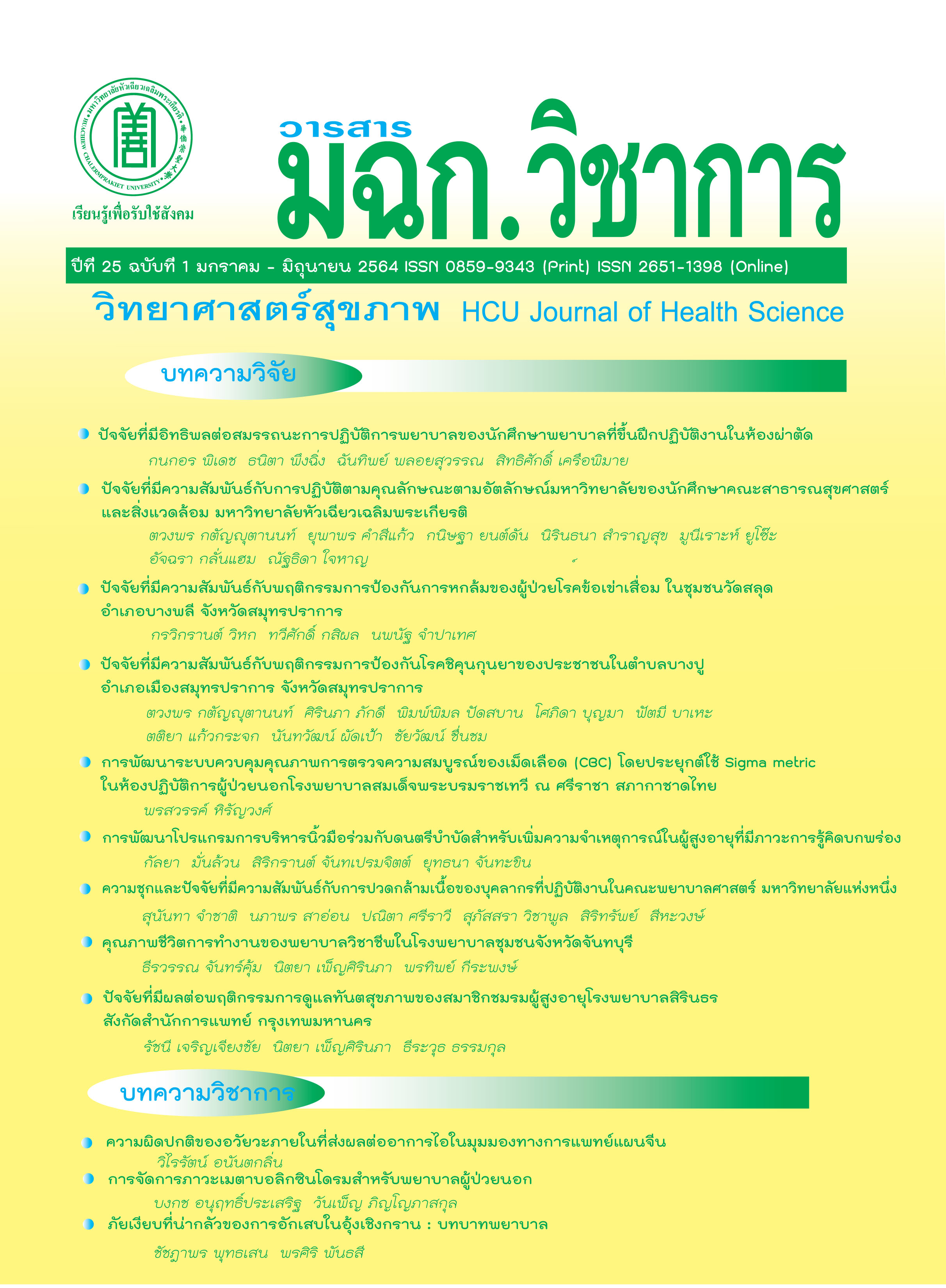ปัจจัยที่ส่งผลต่อประสิทธิภาพการทำงานของพนักงานโรงงานผลิตชิ้นส่วนยานยนต์ในจังหวัดชลบุรี
Factors affecting the work efficacy of employees of automotive parts factories at Chonburi province.
คำสำคัญ:
อันตรายต่อสุขภาพ, ประสิทธิภาพการทำงาน, โรงงานผลิตชิ้นส่วนยานยนต์บทคัดย่อ
สภาพแวดล้อมในการทำงานที่ปลอดภัยต่อสุขภาพเป็นความคาดหวังของผู้ปฏิบัติงานที่ช่วยสร้างเสริมประสิทธิภาพในการปฏิบัติงาน การวิจัยนี้เป็นการศึกษาภาคตัดขวาง (cross sectional study) เพื่อประเมินการรับสัมผัสอันตรายต่อสุขภาพจากสภาพแวดล้อมในการทำงานของพนักงาน ประเมินความคิดเห็นของพนักงานเกี่ยวกับประสิทธิภาพในการปฏิบัติงาน หาความแตกต่างของประสิทธิภาพการปฏิบัติงานระหว่างเพศ และหาความสัมพันธ์ระหว่างปัจจัยคุกคามสุขภาพจากสภาพแวดล้อมในการทำงานกับประสิทธิภาพการปฏิบัติงานของพนักงาน ศึกษาในตัวอย่างจำนวน 67 คน โดยเครื่องมือที่ใช้เป็นแบบสอบถาม และวิเคราะห์ข้อมูลด้วยสถิติ t-test และสหสัมพันธ์แบบเพียร์สัน (Pearson correlation)
ผลการวิจัย พบว่า ตัวอย่างส่วนใหญ่เป็นเพศชาย มีอายุระหว่าง 23-35 ปี การศึกษาต่ำกว่าระดับปริญญาตรี ระยะเวลาที่ปฏิบัติงานที่บริษัท 10-17 ปี มีรายได้ต่อเดือนอยู่ระหว่าง 9,000 – 26,000 บาท มีโอกาสในการรับสัมผัสอันตรายต่อสุขภาพจากสภาพแวดล้อมในการทำงานในภาพรวมอยู่ในระดับปานกลาง (ค่าเฉลี่ย = 2.97±.08) โดยมีโอกาสในการรับสัมผัสอันตรายด้านกายภาพสูงที่สุด (ค่าเฉลี่ย = 3.22±.97) ประเด็นที่ได้รับสัมผัสอยู่เป็นประจำสามอันดับแรกได้แก่ เสียงดัง บรรยากาศที่ร้อน และความร้อนจากเครื่องจักร (ร้อยละ 37.50 35.80 และ 28.40 ตามลำดับ) สำหรับประสิทธิภาพการทำงานในภาพรวมอยู่ในระดับมาก (ค่าเฉลี่ย= 3.97±.56) ประสิทธิภาพในการทำงานของพนักงานชายมากกว่าหญิงอย่างมีนัยสำคัญทางสถิติ (p = 0.004) และโอกาสในรับสัมผัสอันตรายด้านชีวภาพและด้านจิตสังคมมีความสัมพันธ์ในทางเดียวกันกับประสิทธิภาพการทำงานอย่างมีนัยสำคัญทางสถิติ (p = 0.01 และ 0.02 ตามลำดับ) แต่สัมพันธ์กันอยู่ในระดับค่อนข้างต่ำ ( r = 0.31 และ 0.27 ตามลำดับ)
Downloads
เอกสารอ้างอิง
2. ไพโรจน์ ทิพมาตร์. หลักการจัดการ. พิมพ์ครั้งที่ 3. กรุงเทพมหานคร: บริษัทไทยร่มเกล้า จํากัด; 2548. หน้า 12-3.
3. ณัฏฐพันธ์ เขจรนันท์. พฤติกรรมองค์การ. กรุงเทพมหานคร: ซีเอดียูเคชั่น; 2551.
4. ถวิลธาราโภชย์. พฤติกรรมมนุษย์กับการพัฒนาตน. กรุงเทพมหานคร; ทิพยวิสุทธิ์; 2543.
5. ครรชิต ยศพรไพบูลย์. ความคาดหวังด้านบริการของผู้โดยสารขาเข้าที่ใช้บริการท่าอากาศยานภายในประเทศ. วารสาร วิชาการมหาวิทยาลัยกรุงเทพ. 2552;8(2),45-55.
6. นิ่มนวน ทองแสน. ปัจจัยที่ส่งผลต่อประสิทธิภาพการทำงานของพนักงานกลุ่มธุรกิจผลิตเครื่องสำอางในเขตจังหวัดปทุมธานี [วิทยานิพนธ์]. ปทุมธานี: มหาวิทยาลัยเทคโนโลยีราชมงคลธัญบุรี; 2557.
7. แอนน์ จิระพงษ์สุวรรณ. สิ่งคุกคามสุขภาพจากสภาพแวดล้อมในการทำงานและการสำรวจสถานประกอบการ. วารสารพยาบาลสาธารณสุข. 2556;27(3):107-10.
8. สมยศ แย้มเผื่อน. ปัจจัยที่มีผลต่อประสิทธิภาพการทำงานของพนักงานปฏิบัติการบริษัทเอเยน มารีน เซอร์วิสส์ จำกัด มหาชน [วิทยานิพนธ์]. กรุงเทพมหานคร: มหาวิทยาลัยศรีนครินทรวิโรฒ; 2551.
9. ชีวรัตน์ ปราสาร, อรพรรณ ชัยมณี. การศึกษาสิ่งคุกคามทางสุขภาพในโรงงานอุตสาหกรรมที่กลุ่มศูนย์การแพทย์เฉพาะทางด้านอาชีวเวชศาสตร์และเวชศาสตร์สิ่งแวดล้อมโรงพยาบาลนพรัตนราชธานีทำการสำรวจ. ธรรมศาสตร์เวชสาร. 2559;16(1):40-7.
10. น้ำฝน ศรีรมย์, ณัฏฐวี ชั่งชัย. การประเมินความเสี่ยงต่อสุขภาพจากสิ่งคุกคามจากสภาพแวดล้อมในการทำงานของพนักงานในสถานประกอบการผลิตชิ้นส่วนยานยนต์. ใน: รายงานสืบเนื่องจากการประชุมวิชาการและนำเสนอผลงานวิจัยระดับชาติ วิทยาลัยเทคโนโลยีสยาม ครั้งที่ 1 “นวัตกรรมการศึกษา เพื่อการพัฒนาอย่างยั่งยืน” วิทยาลัยเทคโนโลยีสยาม. กรุงเทพมหานคร: วิทยาลัยเทคโนโลยีสยาม; 2558. หน้า 288-99.
11. ชนกานต์ สกุลแถว. ความร้อนกับการทำงาน. วารสารวิทยาศาสตร์และเทคโนโลยี. 2556:21-4.
12. กิตติยา ฐิติคุณรัตน. ประสิทธิภาพการปฏิบัติงานของพนักงานบริษัทซันไชน์อินเตอร์เนชั่นแนล จํากัด [วิทยานิพนธ์]. จันทบุรี: มหาวิทยาลัยราชภัฏรําไพพรรณี; 2556.
13. สราวุธ สิทธิพจน, อมรรัตน สนธิไทย. TOTAL PRODUCTIVE MAINTENANCE. กรุงเทพมหานคร: สถาบันเพิ่มผลผลิตแหงชาติ: 2544.
14. สมศักดิ์ สุวรรณมิตร, ดำรงค์ ทวีแสงสกุลไทย. การปรับปรุงคุณภาพของผลิตภัณฑ์รถยนต์บรรทุก 2 ตัน โดยใช้เทคนิค QFD. วารสารวิจัย มข. 2553;15(7): 656-69.
15. ธีรพันธ์ ลมูลศิลป์, วัชระ ยี่สุ่นเทศ. แรงจูงใจที่มีความสัมพันธ์กับประสิทธิภาพในการปฏิบัติงานของพนักงานฝ่ายผลิตโรงงานผลิตชิ้นส่วนยานยนต์. วารสารวิชาการวิทยาลัยนตพล. 2562;5(1):76-84.
16. Smith, D.R., Wei, N., Zhao, L., & Wang R-S. Musculoskeletal complaints and psychosocial risk factors among Chinese hospital nurses. Occupational Medicine. 2004;54(8):579-82.
17. สำนักโรคจากการประกอบอาชีพและสิ่งแวดล้อม กรมควบคุมโรคกระทรวงสาธารณสุข. คู่มือการประเมินความเสี่ยงจากการทำงานของบุคลากรในโรงพยาบาล. กรุงเทพมหานคร: โรงพิมพ์ชุมนุมสหกรณ์การเกษตรแห่งประเทศไทยจำกัด; 2550.
18. คณะกรรมการวิชาการวิศวกรรมเครื่องกล. มาตรฐานระบบปรับอากาศและระบายอากาศ. กรุงเทพมหานคร: วิศวกรรมสถานแห่งประเทศไทยในพระบรมราชูปถัมป์; 2559.
ดาวน์โหลด
เผยแพร่แล้ว
รูปแบบการอ้างอิง
ฉบับ
ประเภทบทความ
สัญญาอนุญาต
บทความที่ได้รับการตีพิมพ์เป็นลิขสิทธิ์ของวารสารวิทยาศาสตร์สุขภาพและสุขภาวะ
ข้อความที่ปรากฏในบทความแต่ละเรื่องในวารสารวิชาการเล่มนี้เป็นความคิดเห็นส่วนตัวของผู้เขียนแต่ละท่านไม่เกี่ยวข้องกับมหาวิทยาลัยหัวเฉียวเฉลิมพระเกียรติ และคณาจารย์ท่านอื่นๆในมหาวิทยาลัยฯ แต่อย่างใด ความรับผิดชอบองค์ประกอบทั้งหมดของบทความแต่ละเรื่องเป็นของผู้เขียนแต่ละท่าน หากมีความผิดพลาดใดๆ ผู้เขียนแต่ละท่านจะรับผิดชอบบทความของตนเองแต่ผู้เดียว




